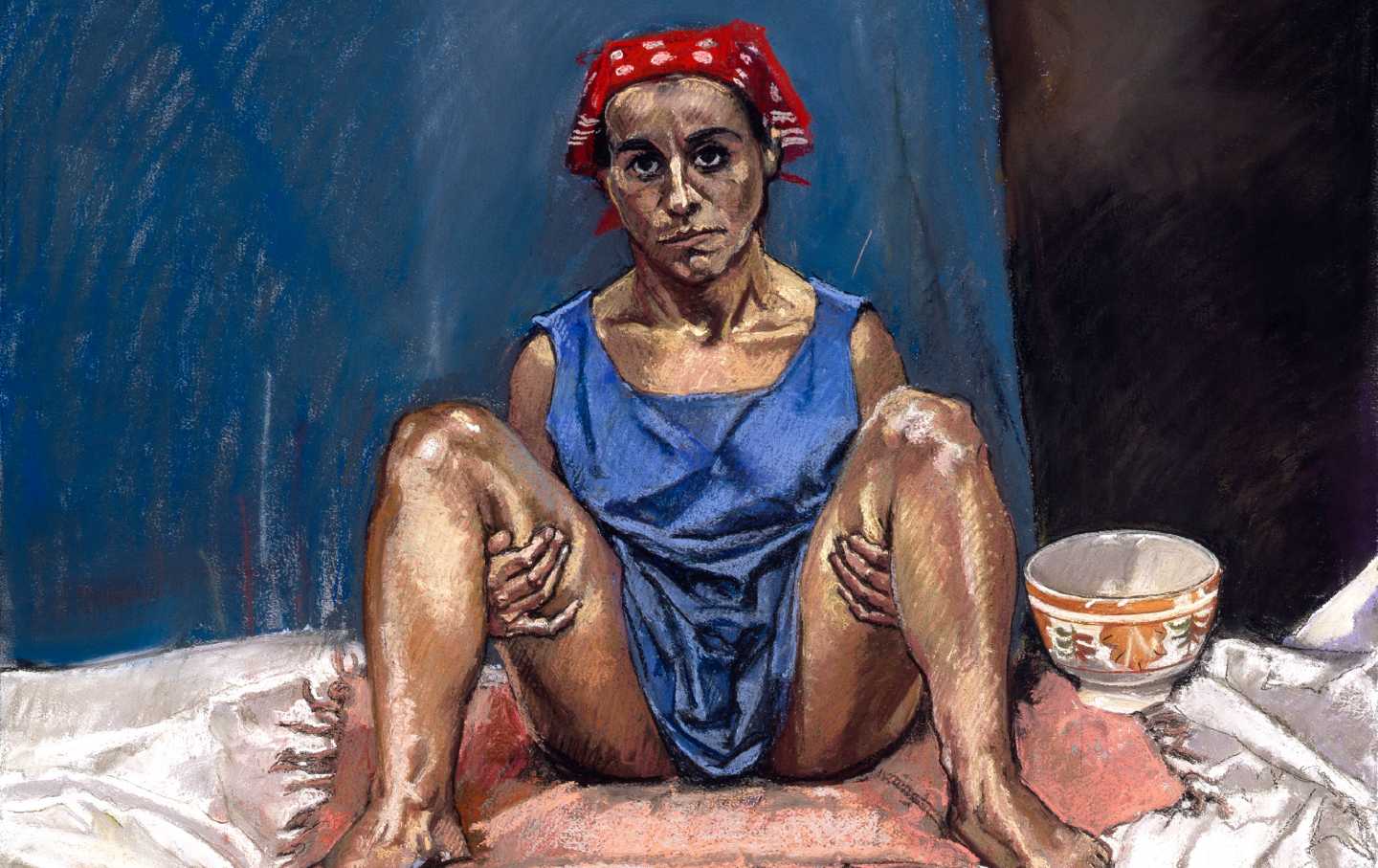
Untitled, #1, by Paula Rego. (Courtesy of the Victoria Miro Gallery)
The violence of the irony: Those Supreme Court justices hand-picked by Mitch McConnell’s dark-money donors oversaw the evisceration of Roe v. Wade only days after the death of Paula Rego.
Rego was the only major artist ever to have created a series of large paintings of women having illegal abortions. Each panel features one individual in the windowless room where her abortion will take place, or has just taken place. Painted more than two decades ago, these 10 pictures—each one called Untitled—so blasted open public consciousness in the artist’s native Portugal that its prime minister proclaimed Rego the single strongest force behind that country’s resounding 2008 “yes” referendum vote in favor of safe, legal abortion.
Rego was born in 1935, three years into regime of António Salazar, the Estado Novo dictator who transmogrified his private religious extremism into the law of the land. For decades, Salazar oversaw Portugal’s terror-controlled colonies in Africa and elsewhere, sent political opponents to the GITMO-like Tarrafal Detention Camp in the Azores, and extolled obedience as a woman’s most cherished virtue. He rolled back the previous government’s modest gestures toward gender equity by decreeing that women could neither hold bank accounts nor travel without permission of a father or husband, and imposed severe restrictions upon women’s right to vote.
Even when a Rego painting isn’t directly about Portugal, there’s often a lingering whiff of Salazar. Whether in The Interrogator’s Garden, with its smiling jackbooted thug relaxing on a patio, or in Snow White and Her Stepmother, in which a woman strips off and inspects a young girl’s underpants for evidence of forbidden sex, Rego was always raising the alarm about power’s eagerness to invade the private realm.
Early on, Rego’s antifascist father had warned that “Portugal’s no place for a woman,” and urged her to get an English education. As a 17-year-old art student in 1950s London, Rego was at first exhilarated by that city’s promise of freedom. But soon after her first sexual encounter—a violent and bloody event perpetrated by a fellow student whom she barely knew—Rego reckoned with the fact that many of the freedoms of this ostensibly democratic country would not extend to her. With no access to contraception, and with male lovers uninterested in condoms and unconcerned about pregnancies, Rego and her female classmates endured multiple back-alley abortions.
Until shortly before she died, Rego had denied ever having had an abortion—a dissembling, she later explained, she deployed in order to prevent the works from being read merely as one individual’s confession, rather than as many women’s testimonies of having made the choice to abort. The adolescent in her school uniform and ankle socks, having a furtive D&C on the way home. The working-class woman who’ll probably have to hurry back to her job right after the procedure. The older middle-class woman, with child-rearing duties behind her, stunned by the fact of a late pregnancy. And so on.
In the pictures’ claustrophobic spaces, the women sit or squat or sprawl across the rude cots, battered sofas, stray desks, and folding chairs serving as ad hoc operating tables. While alongside the women are basins, buckets, and chamber pots at the ready, Rego offers nothing to titillate the pain-porn fetishists—no displays of genitals or gore or the invasive tools of the trade. Instead, the artist zeroes in on the gravity of each woman’s demeanor; we can read the specific terms of her decision in the set of her jaw or the directness of her gaze. Specific body parts articulate pain anticipated or pain experienced, from the torque of hips to the grip of toes to the dig of heels and elbows. While Rego’s intention was to present her subjects as people of action making sober and lucid decisions, a number of journalists writing about the pictures offered a facile solidarity, parading their own compassion by describing the picture’s subjects as downtrodden. To which the indignant Rego shot back: “These women are not victims.”
Rego died before she could have denounced the ax-blade of retribution swung at women by the pious and vengeful US Supreme Court majority. But I have a modest proposal: Let’s repurpose the SCOTUS building’s Court Chamber, now vacated for summer recess, as an exhibition space in which to honor both Rego and the US women fighting for bodily autonomy. This summer, Paula Rego’s 10 abortion pictures should hang suspended by wires against that room’s famous blood-red draperies. For those three months, let Rego’s insubordinate pictures redeem that disgraced chamber.
Margaret SpillaneMargaret Spillane, a longtime Nation contributor, teaches visual and performing art criticism at Yale.